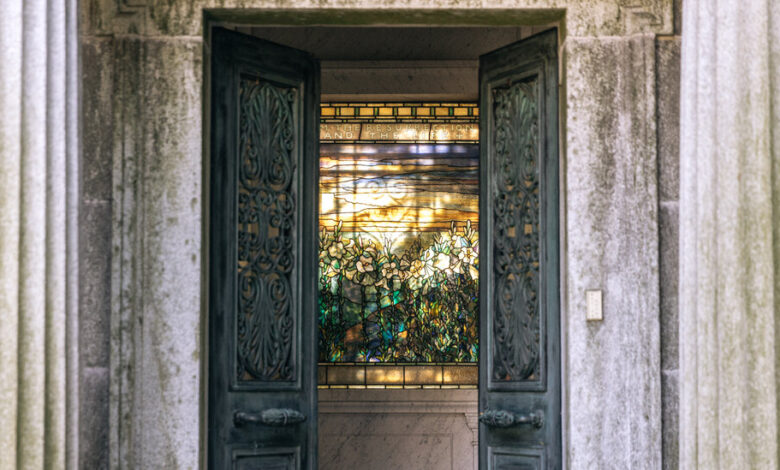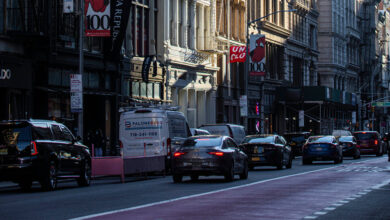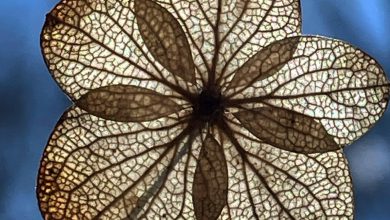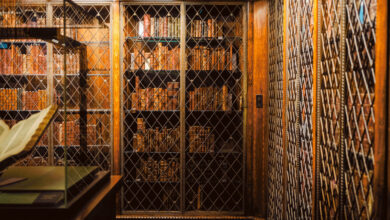What’s Hidden in Woodlawn’s Mausoleums? Extraordinary Stained Glass.

On a sunny Bronx morning late last year, an all-star team of stained-glass experts prepared to enter a dank 1894 tomb at Woodlawn Cemetery that had been opened just once in the past century.
The mausoleum at hand held the remains of José Maria Muñoz, a Panamanian-born New York merchant and son of a Spanish general. The scholarly tomb raiders were five energetic stained-glass conservators and art historians conducting an unprecedented survey of some 1,200 stained-glass windows that were installed in free-standing Woodlawn mausoleums from 1878 to the present.
Woodlawn sits on 400 rolling acres ornamented with 1,300 such private family mausoleums, including extravagant Gilded Age temples erected for captains of industry, robber barons and the merely very wealthy. These titans of affluence and their spouses often spent lavishly on the adornment of their final resting places — even if the interiors of these grand structures weren’t destined to be seen by more than friends and family.
As soon as the team entered the mausoleum, shrieks could be heard bouncing off the interior stone walls. The experts had discovered a variety of stained glass none of them had ever encountered before.
On the back wall of the sepulcher, behind the stone sarcophagus that filled most of the clammy chamber, a jeweled blue-glass orb protruded from the flat plane of a stained-glass window — breaking through into the third dimension.
“I’m freaking out!” said Brianne Van Vorst, a conservator with Liberty Stained Glass Conservation. “This is wild!”
“Oh my gosh! Look at the three-dimensionality!” cried Lindsy R. Parrott, executive director and curator of the Neustadt, a major collection of stained glass by the master artist Louis Comfort Tiffany.
“I’ve never seen anything like this before, anywhere,” said Drew Anderson, a conservator at the Metropolitan Museum of Art.
The yearslong survey, conducted with the guidance of Alice Cooney Frelinghuysen, a curator of American decorative arts at the Met, will include a condition assessment, photographic documentation and archival research on every stained-glass window in Woodlawn’s vast and varied collection.
To gain entry to some of the cemetery’s long-sealed burial vaults, a local company cleverly adapted antique keys for mausoleums built by the same maker in the late 19th century.
“It feels totally like ‘Indiana Jones,’” Ms. Frelinghuysen said. “Sometimes we walk in and there’s that feel of damp, mold and leaves, and you see an incredible window you’ve never seen before.”
Woodlawn, by virtue of the breadth of its window collection, is a virtual museum of stained-glass techniques and styles from the late 19th and early 20th centuries. But until now, that collection had not been comprehensively studied. So the survey team relishes the opportunity to view so many long-concealed artworks in their original context, considering them in terms of art history, patronage, architecture, religion and technology.
“We’re trying to give a greater understanding to the diversity of stained-glass makers in America through the discovery of windows we can now attribute to different makers, most of whom most people have never heard of, and some we’ve never heard of,” said Ms. Frelinghuysen, an authority on Tiffany glass.
Before the last quarter of the 19th century, stained-glass windows were traditionally created by painting and staining the surface of white and colored glass. Highlights ranging from pale yellow to deep orange were achieved by applying silver nitrate to the back of the pane and firing it.
Beginning in the Gilded Age, however, Tiffany and John La Farge revolutionized the world of American stained-glass windows with their innovative uses of opalescent glass, a material characterized, according to Ms. Parrott, by “an internal glow and a milky translucency that captures light and amplifies color.”
Tiffany introduced glass in a broad color palette, which he used, along with glass of varying textures and opacities, to create intricately detailed pictorial compositions admired for their painterly effects. Paint itself was generally kept to a minimum, for judiciously chosen details like the face and hands of a figure.
Woodlawn has at least two windows by La Farge and more than 60 by Tiffany, and the survey, which is about half completed, has resulted in the fresh identification of unsigned Tiffany works of great beauty and originality.
In the case of two recently surveyed windows, “nobody had ever seen those Tiffanys since the bodies went in and the last family members visited,” said Susan Olsen, the director of historical services at Woodlawn, who is overseeing the project.
The survey is also illuminating obscure corners of the American stained-glass industry.
“The general public loves Tiffany and celebrates La Farge, but there were so many other studios who were producing superlative work, employing amazing designers, craftspeople and artisans and taking bold risks using this new American material of opalescent glass in innovative, exciting ways,” said Ms. Parrott, the Neustadt curator. “But the studios were small and maybe not around for long, and so they’ve been lost to the annals of history — until now.”
Among the unsung artists whose work the team has been identifying and exploring is Edward Sperry, a designer who worked for Tiffany for 15 years. Mr. Sperry helped found another studio called the Church Glass and Decorating Company, ran the ecclesiastical department of the Gorham Manufacturing Company and finally established his own stained-glass studio.
The 1907 window of the William Rhinelander mausoleum at Woodlawn, signed by Mr. Sperry, depicts an angel kneeling before a cross. This and other windows “are beautifully designed and constructed, with distinctive rendering of his figures’ faces that speaks to Sperry’s skill as a trained painter,” said Sophia Kamps, the survey’s research associate.
The Walter Janes Studio was another lesser-known glass maker that produced fine windows at Woodlawn. Though the works are unsigned, the team was able to identify Janes as the creator of two windows in one mausoleum — one depicting Victory as a winged, sword-wielding angel — through references in an Ohio trade publication and an Architectural League of New York yearbook.
But the survey has unearthed many unsolved mysteries, like the protruding orb in the Muñoz mausoleum, whose creator is unknown. Research on such matters can be tricky, because the Woodlawn archives include the name of the company that built each mausoleum but not the subcontracting stained-glass maker.
To the conservators on the survey project, the priority is evaluating the condition of Woodlawn’s old and often deteriorated windows and conducting triage to determine which are in most urgent need of care.
After opening the column-flanked bronze doors of the 1899 mausoleum of J.G. Payntar, to which Woodlawn gained access last year for the first time since 1915, the art historians quickly concluded that its window was an unsigned Tiffany work.
Notable for its richly saturated colors and the subtle variation of its shading and textures, the window depicted an angel gazing downward as a fiery sun set behind a mountain. Ms. Frelinghuysen and Ms. Parrott speculated that the window might be a collaboration between two top Tiffany designers: Frederick Wilson, an Englishman known for his fine ecclesiastical figures, and Agnes F. Northrop, a marvel with foliage and landscapes.
“It’s fabulous,” Ms. Frelinghuysen said, noting the way rippled blue and green glass had been chosen to simulate the water at the angel’s feet.
“But it’ll never be right until we fix the face,” said Mr. Anderson, who, like Ms. Frelinghuysen and Ms. Parrott, is donating his expertise to the survey. (The other team members are being compensated by Woodlawn.)
Indeed, the painted facial features of the angel had all but vanished, a loss that Mr. Anderson said might have been caused by moisture attacking the window glass and the powdered glass in the paint.
He and Ms. Van Vorst emphasized that they hoped this project would influence others in their field to approach stained glass conservatively: Instead of replacing the faded face with a new one painted on a fresh piece of glass and throwing away the original, Mr. Anderson said, the team’s conservators would retain the original ghost image of the face and “reintroduce paint in a reversible way,” such as by painting facial features on a separate plate of glass and placing it behind the faded face.
“The majority of these windows have never been conserved, they’re untouched,” Ms. Olsen said. “It’s important that all cemeteries know that the initial approach with a conservator is so important.”
As the survey rolls along, Ms. Olsen is contacting descendants of mausoleum owners to “ask them to take ownership of their family property” by supporting the conservation of their memorial windows, either financially or by giving Woodlawn permission to pursue conservation. She hopes one day to establish a stained-glass conservation studio right on the cemetery grounds.
Often, the story behind a Gilded Age tomb is an intriguing web of art, architecture and patronage.
Picture “the same architect associated with their Manhattan mansion and their Newport cottage” receiving a momentous final commission from a powerful client, Ms. Olsen said: “There they are at dinner with Stanford White and they say, ‘OK, Stanny, I have one more project for you: my mausoleum at Woodlawn.’”
Source link






